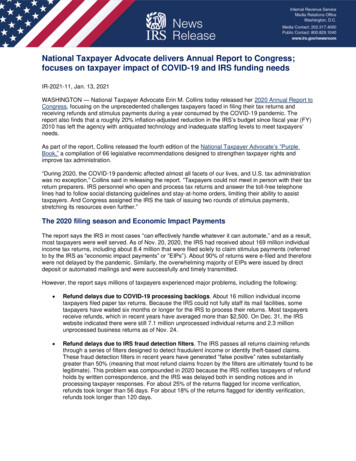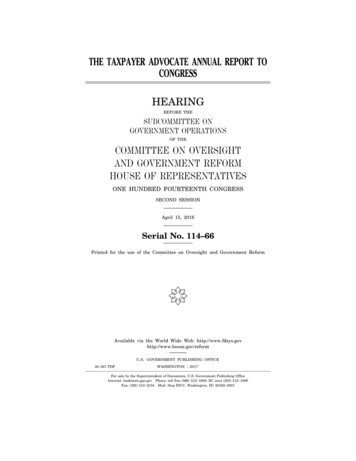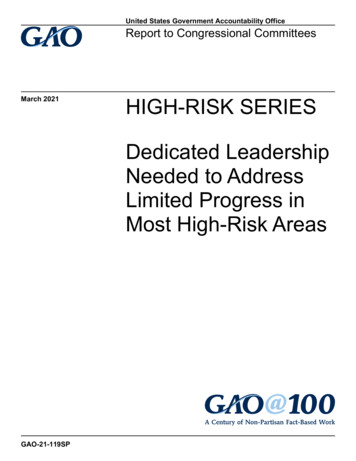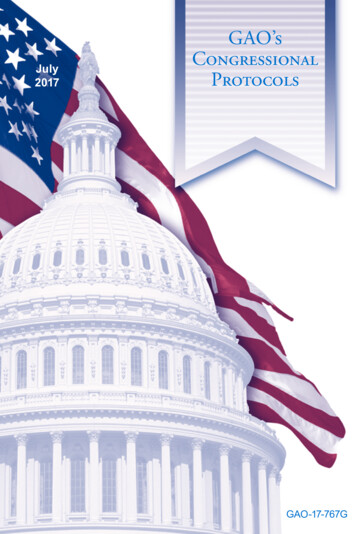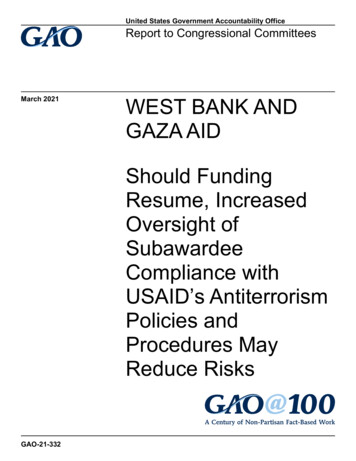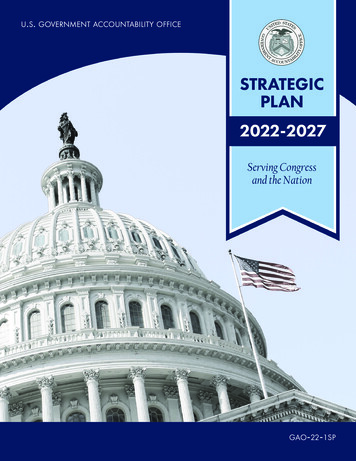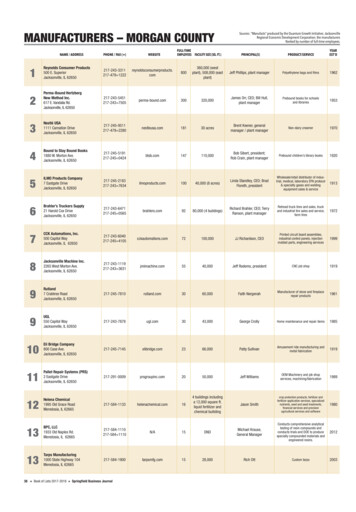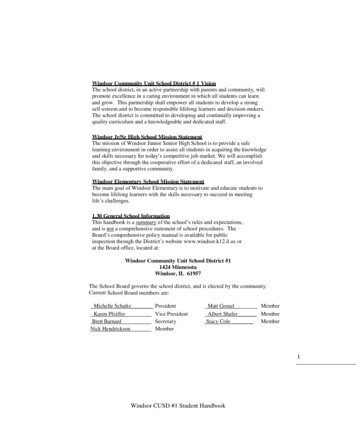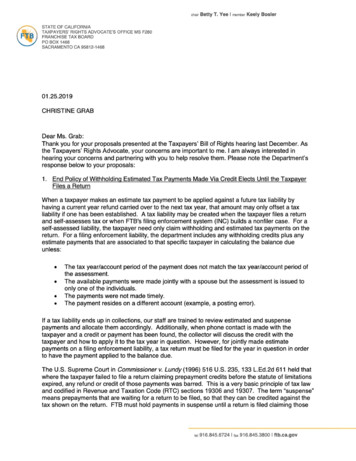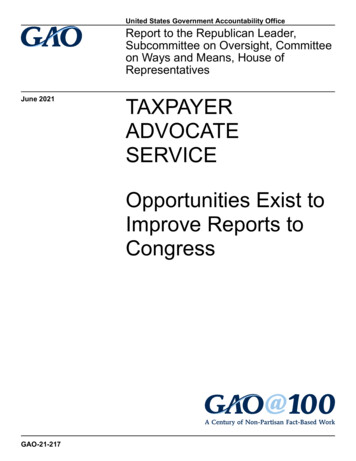
Transcription
United States Government Accountability OfficeReport to the Republican Leader,Subcommittee on Oversight, Committeeon Ways and Means, House ofRepresentativesJune 2021TAXPAYERADVOCATESERVICEOpportunities Exist toImprove Reports toCongressGAO-21-217
June 2021TAXPAYER ADVOCATE SERVICEOpportunities Exist to Improve Reports to CongressHighlights of GAO-21-217, a report to theRepublican Leader, Subcommittee onOversight, Committee on Ways and Means,House of RepresentativesWhy GAO Did This StudyWhat GAO FoundTAS, an independent office within IRS,helps taxpayers resolve problems withIRS and addresses broader, systemicissues that affect groups of taxpayersby recommending administrative andlegislative changes to mitigate suchproblems. Congress mandated thatTAS issue two reports every year—oneknown as the annual report whichincludes sections on, among otherthings, the 10 most serious problemsencountered by taxpayers, and theother known as the objectives reportthat discusses organizationalobjectives.The budget for the Internal Revenue Service’s (IRS) Taxpayer Advocate Service(TAS) declined by about 14 percent from fiscal years 2011 to 2020, whenadjusted for inflation. For fiscal year 2020, TAS used most of its resources toassist individual taxpayers, known as case advocacy. TAS allocated about76 percent of its 222 million budget and 86 percent of its almost 1,700 full-timeequivalents to this purpose. The percentage of resources for case advocacy hasdecreased during the past decade—in fiscal year 2011 about 85 percent of thebudget was devoted to it. For the same period, resources to address broaderissues affecting groups of taxpayers, known as systemic advocacy, increasedfrom 9 percent to 14 percent of the total budget. This shift is due in part to thereallocation of staff to better integrate systemic advocacy work and TAS’s overallattrition rate more than doubling to 15.9 percent between fiscal years 2011 and2019.GAO was asked to review how TAScarries out its mission, focusing onresources and reporting. This report (1)describes TAS’s resources andworkload, and (2) assesses TAS’sreporting to Congress and identifiesopportunities for improvement.GAO reviewed documents from TAS,IRS, and other sources, includingTAS’s annual and objectives reportsand internal guidance; analyzed TAS’sbudget, staffing, and workload data forfiscal years 2011 through 2020; andinterviewed knowledgeable TAS andIRS officials. GAO assessed TAS’sreporting of its objectives andperformance against statutoryrequirements, relevant internal controlstandards, and selected key practicesfor performance reporting developedby GAO. In addition, GAO reviewedrelevant TAS web pages, analyzed thelength and composition of TAS’sreports, and interviewed keycongressional committee staff toidentify additional options to improveTAS’s reporting.View GAO-21-217. For more information,contact James R. McTigue, Jr. at (202) 5126806 or mctiguej@gao.gov.Since 2011, TAS has received more than 2 million taxpayer cases, of whichalmost half were referrals from other IRS offices. TAS closed more cases than itreceived each year from 2012 to 2017, but its inventory has grown since fiscalyear 2018, due in part to attrition in case advocacy staff and an increase intaxpayers seeking assistance (see figure below).Number of Taxpayer Cases Received and Closed, Fiscal Years 2011 to 2020TAS has recently modified its two mandated reports to Congress by reducingtheir length and separately compiling legislative recommendations. It shortenedits annual reports in part because the Taxpayer First Act reduced the requirednumber of most serious taxpayer problems from “at least 20” to “the 10” mostserious problems. GAO identified the following additional actions that couldfurther improve TAS reporting.United States Government Accountability Office
What GAO RecommendsGAO is making sevenrecommendations to help improve theusefulness of TAS’s reports. GAOrecommends, among other things, thatthe National Taxpayer Advocate takethe following actions: Clearly identify TAS’s objectivesfor the upcoming fiscal year andlink them to TAS’s plannedactivities. Define measurable outcomes forTAS’s objectives. Expand TAS’s reporting beyondplanned activities to include theactual results it achieved throughthose activities. Consult with congressionalstakeholders—at least once every2 years—and other relevantstakeholders to obtain input onTAS’s goals and measures andbetter understand stakeholders’information needs. Publish updates on the inventoryof IRS’s actions taken, partiallytaken, or not taken in response torecommendations made in themost serious problems section ofTAS’s annual report.TAS agreed with all of GAO’srecommendations.Report outcome-oriented objectives and progress. The objectives for theupcoming fiscal year that TAS included in its most recent report are not alwaysclearly identified and do not link to the various planned activities that aredescribed. Further, the objectives TAS does identify do not include measurableoutcomes. In addition, TAS’s reports do not include the actual results achievedagainst objectives so it is not possible to assess related performance andprogress. Improved performance reporting could help both TAS and Congressbetter understand which activities are contributing toward achieving TAS’sobjectives and where actions may be needed to address any unmet goals.Consult with Congress and other stakeholders. TAS briefs congressionalcommittees each year after publishing its annual report and solicits perspectivesfrom stakeholders. TAS officials said they incorporate the perspectives into itsobjectives. However, TAS does not follow leading practices to consultcongressional committees about its goals and objectives prior to publication atleast once every 2 years. Thus, it misses opportunities to obtain congressionalinput on its objectives and performance reporting. Consultations would provideTAS opportunities to confirm if its goals incorporate congressional and otherstakeholder perspectives and whether its reports meet their information needs.Publish updates on recommendation implementation status. By law, TAS’sannual report must include an inventory of actions IRS has fully, partially, and notyet taken on TAS’s recommendations to address the most serious problemsfacing taxpayers. If those recommendations take multiple years to implement,which some have as shown in the table below, updating the inventory would berequired. In its objectives reports, TAS provides only a one-time inventory of IRSresponses to TAS’s recommendations made during the preceding year, includingplans and preliminary actions taken for those IRS accepts for implementation.TAS does not publicly update the inventory in subsequent annual reports toreflect actions IRS takes or does not take to address TAS’s recommendations.This reporting approach does not provide complete information on the status ofactions IRS has taken to address serious problems facing taxpayers and alsodoes not provide the information in the annual report, as required. Publishingsuch updated status information would support congressional oversight.Taxpayer Advocate Service’s (TAS) Recommendation Reporting and Status as of the FourthQuarter of Fiscal Year 2020GAO also identified options for TAS to consider to improve its reporting. Theseoptions include explaining changes to the list of the most serious taxpayerproblems from year to year and streamlining report sections congressional staffuse less frequently.
ContentsLetter1BackgroundTAS Allocates the Majority of Its Resources to Help IndividualTaxpayers, and Its Workload Has Increased in Recent YearsTAS Has Multiple Opportunities to Improve the Usefulness of ItsReporting to CongressConclusionsRecommendations for Executive ActionAgency Comments and Our Evaluation426414142Appendix IScope and Methodology44Appendix IIOverview of the Case Advocacy Process48Appendix IIIReporting Requirements51Appendix IVDiscussion of Additional Options to Improve Taxpayer AdvocateService Reporting54Appendix VComments from the Taxpayer Advocate Service60Appendix VIGAO Contact and Staff Acknowledgments6412FiguresFigure 1: Sources and Types of Work for the Taxpayer AdvocateService’s Primary FunctionsFigure 2: Trend in Total Page Length of Taxpayer AdvocateService (TAS) Annual Report and Objectives ReportFigure 3: Taxpayer Advocate Service (TAS) Budget, Fiscal Years2011 to 2020Page i51011GAO-21-217 Taxpayer Advocate Service
Figure 4: Taxpayer Advocate Service Budget and Full-TimeEquivalents (FTE) by Functional Area, Fiscal Years 2011to 2020Figure 5: Taxpayer Advocate Service Budget and Full-TimeEquivalents (FTE) by Functional Area, Fiscal Years 2011and 2020Figure 6: Budget and Full-Time Equivalents (FTE) for Programs inthe Systemic Advocacy Function, Fiscal Years 2011 and2020Figure 7: Taxpayer Advocate Service (TAS) Received More than 2Million Taxpayer Cases from Fiscal Years 2011 to 2020Figure 8: Number of Taxpayer Cases the Taxpayer AdvocateService (TAS) Received by Case Type from Fiscal Years2011 to 2020Figure 9: Taxpayer Advocate Service (TAS) Cases Received bySource, Fiscal Years 2011 to 2020Figure 10: Number of Taxpayer Cases Received and Closed,Fiscal Years 2011 to 2020Figure 11: Median Number of Days for the Taxpayer AdvocateService (TAS) to Close Taxpayer Cases, Fiscal Years2011 to 2020Figure 12: Number of Systemic Advocacy Projects Created byProject Type, Fiscal Years 2011 to 2020Figure 13: Illustrative Example of Agency Goal FrameworkFigure 14: Taxpayer Advocate Service’s (TAS) RecommendationReporting and Status as of the Fourth Quarter of FiscalYear 2020Figure 15: Options GAO Identified to Improve Taxpayer AdvocateService’s (TAS) Reporting to CongressFigure 16: Overview of the Taxpayer Advocate Service’s (TAS)Case Advocacy ProcessFigure 17: Taxpayer Advocate Service’s (TAS) Annual ReportPage Length by SectionPage ii1213151718202223252935404958GAO-21-217 Taxpayer Advocate Service
AOTASthe AdvocateCentralized Case IntakeCoronavirus Disease 2019Economic Impact Paymentfull-time equivalentGovernment Performance and Results Act of 1993Internal Revenue ManualInternal Revenue ServiceInformation TechnologyLow Income Taxpayer ClinicOperations Assistance RequestTaxpayer Assistance OrderTaxpayer Advocate ServiceNational Taxpayer AdvocateThis is a work of the U.S. government and is not subject to copyright protection in theUnited States. The published product may be reproduced and distributed in its entiretywithout further permission from GAO. However, because this work may containcopyrighted images or other material, permission from the copyright holder may benecessary if you wish to reproduce this material separately.Page iiiGAO-21-217 Taxpayer Advocate Service
Letter441 G St. N.W.Washington, DC 20548June 16, 2021The Honorable Mike KellyRepublican LeaderSubcommittee on OversightCommittee on Ways and MeansHouse of RepresentativesDear Mr. Kelly:Congress created the Taxpayer Advocate Service (TAS), an independentoffice within the Internal Revenue Service (IRS), to assist taxpayers withproblems not resolved through normal IRS channels. 1 TAS divides itswork into two primary functions: (1) case advocacy, which involveshelping taxpayers resolve individual problems with IRS, such as thosecausing financial difficulty or arising from a failure in IRS’s processes; and(2) systemic advocacy, which involves proposing administrative andlegislative changes to mitigate problems affecting groups of taxpayers.According to TAS, since commencing operations in March 2000, TAS hasreceived more than 4 million taxpayer cases and has proposed more than1,700 recommendations to IRS and nearly 300 legislativerecommendations in its annual reports to Congress.By statute, TAS is required to submit two reports to Congress each year. 2The annual report, due by December 31 of each year, presents the mostserious problems encountered by taxpayers, and administrative andlegislative recommendations for resolving taxpayer problems. 3 Theannual report also is to identify TAS initiatives and IRS responsiveness126U.S.C. § 7803(c)(1)(A). The Office of the Taxpayer Advocate is now known as theTaxpayer Advocate Service.226U.S.C. § 7803(c)(2)(B).3Inthis report, we refer to TAS’s report to Congress due at the end of each year as theannual report, as it is labeled by TAS. It is referred to as the activities report in 26 U.S.C.§ 7803(c)(2)(B)(ii), but TAS does not use that label.Page 1GAO-21-217 Taxpayer Advocate Service
during the prior fiscal year. 4 The objectives report, due by June 30 ofeach year, must identify TAS’s objectives for the coming fiscal year.The Taxpayer First Act modified TAS’s annual reporting to reduce therequired number of most serious taxpayer problems in the annual reportfrom “at least 20” to “the 10” most serious problems. 5You asked us to review how TAS carries out its mission, with a focus onresources and reporting. This report (1) describes TAS’s resources andworkload to carry out its advocacy functions, and (2) assesses TAS’sreporting to Congress and identifies opportunities for improvement.To describe TAS’s resources and workload to carry out its advocacyfunctions, we reviewed IRS and TAS documentation, such as IRS’sInternal Revenue Manual and TAS’s annual program letters,management reports, and guidance memorandums related to theCoronavirus Disease 2019 (COVID-19) pandemic. We analyzed budgetand staffing data from fiscal years 2011 to 2020 and adjusted budgetamounts for inflation using 2020 dollars.TAS’s management reports summarize workload and performance datafrom its Taxpayer Advocate Management Information System andSystemic Advocacy Management System, the information systems usedto track individual cases and systemic advocacy activities, respectively.We assessed the reliability of TAS’s resources and workload data,including data from IRS’s systems, by reviewing relevant documentationand interviewing knowledgeable TAS officials. We also assessed thereliability of data from IRS’s systems by reviewing relevant documentationfrom our audit on IRS’s financial statement. 6 We determined that the dataused in our analysis were sufficiently reliable for our reporting purposes.To assess TAS’s reporting to Congress and identify opportunities forimprovement, we reviewed relevant federal statutes and various TASreporting activities. We reviewed the most recent objectives report and4TASlabels its annual reports by calendar year, even though it is required to report onactivities from the prior fiscal year. We did not assess this time frame difference in thisreview.5Pub.L. No. 116-25, § 1301(b)(1), 133 Stat. 981, 992 (2019).6GAO,Financial Audit: IRS’s FY 2020 and FY 2019 Financial Statements, GAO-21-162(Washington, D.C.: Nov. 10, 2020).Page 2GAO-21-217 Taxpayer Advocate Service
assessed TAS’s reporting of its objectives against key practices forperformance management based on the Government Performance andResults Act of 1993, as amended, and Standards for Internal Control inthe Federal Government. 7 We determined that the information andcommunication component of internal control was significant to thisassessment, along with the underlying principle that management shouldexternally communicate quality information to achieve the agency’sobjectives. We assessed how TAS identified objectives in its objectivesreport to determine whether they were clearly communicated.We assessed TAS’s reporting of IRS’s actions to address annual reportrecommendations against relevant statutory reporting requirements. 8 Wealso determined that the internal control standard and underlying principlethat management should externally communicate quality information wassignificant to this assessment. 9 We assessed TAS’s externalcommunication to determine whether it provided the informationCongress needs to help TAS carry out its work.We compared how TAS reported its process for reviewing annual reportstatistical information (data) with IRS against the relevant statutoryreporting requirement. 10 We determined that the control activitiescomponent of internal control was significant to this assessment, alongwith the related principle that management should implement controlactivities through documented policies. 11 Therefore, we assessed theextent to which TAS documented its policies and procedures forreviewing annual report data with IRS to determine whether thedocumentation helps TAS report reliable and accurate information.To identify additional options to improve TAS’s reporting, we reviewedTAS’s reports from 2011 through the most recent reports published at thetime of our review: the 2020 annual report and fiscal year 2021 objectives7GAO,Standards for Internal Control in the Federal Government, GAO-14-704G(Washington, D.C.: Sept. 10, 2014).826U.S.C. § 7803(c)(2)(B)(ii)(IV)-(VI). TAS has traditionally made recommendations onlyin the most serious problems section. However, in its 2019 and 2020 annual reports, TASmade recommendations in other sections. We focused on the most serious problemssection based on feedback from congressional committee staff that they used this sectionfrequently.9GAO-14-704G.1026U.S.C. § 7803(c)((2)(B)(ii)(XII).11GAO-14-704G.Page 3GAO-21-217 Taxpayer Advocate Service
report. We obtained perspective on how Congress perceives and usesTAS’s reports through interviews with congressional staff from the HouseCommittee on Ways and Means and Senate Committee on Finance, thestatutory recipients of TAS’s reports, as well as staff from the JointCommittee on Taxation. We also requested and received input from othercongressional committees that potentially use TAS’s reports.We also interviewed the National Taxpayer Advocate and TAS staffresponsible for planning, researching, and drafting TAS’s congressionalreports. We shared potential options for improvement with TAS officialsfor their comment. Appendix I provides additional details about thisengagement’s scope and methodology.We conducted this performance audit from January 2020 to June 2021 inaccordance with generally accepted government auditing standards.Those standards require that we plan and perform the audit to obtainsufficient, appropriate evidence to provide a reasonable basis for ourfindings and conclusions based on our audit objectives. We believe thatthe evidence obtained provides a reasonable basis for our findings andconclusions based on our audit objectives.BackgroundTAS is an independent office within IRS created to assist taxpayers inresolving problems with IRS, identify areas in which taxpayers haveproblems in dealing with IRS, and propose administrative and legislativechanges to mitigate such problems. The National Taxpayer Advocate(Advocate) is appointed by the Secretary of the Treasury, afterconsultation with the Commissioner of Internal Revenue and the InternalRevenue Service Oversight Board, and reports directly to theCommissioner. 12 The current Advocate joined TAS in March 2020.TAS has 80 local offices, with at least one in each state, the District ofColumbia, and Puerto Rico. In fiscal year 2020, TAS employed almost1,700 full-time equivalent positions, or about 2 percent of IRS’s workforce.1226U.S.C. § 7803(c)(1)(B). The IRS Oversight Board oversees IRS administration,management, conduct, direction, and supervision of the execution and application of theinternal revenue laws or related statutes and tax conventions to which the United States isa party. 26 U.S.C. § 7802. The board suspended operations in 2015 because it does nothave enough members confirmed by the U.S. Senate to make up a quorum.Page 4GAO-21-217 Taxpayer Advocate Service
TAS has two primary functions—case advocacy and systemic advocacy(see fig. 1). It also has a headquarters function that includes humanresources and financial operations.Figure 1: Sources and Types of Work for the Taxpayer Advocate Service’s Primary FunctionsaTaxpayers can call the National Taxpayer Advocate toll-free line, staffed by IRS employees, whenthey are seeking TAS assistance. If the toll-free phone assistor believes the inquiry meets TAS caseacceptance criteria, the assistor will transfer the caller to TAS’s Centralized Case Intake phone lineduring normal business hours.bThe Purple Book is a compilation of TAS’s legislative recommendations to Congress and is aseparate volume of TAS’s annual report.Case AdvocacyThrough case advocacy, TAS assists taxpayers whose tax problems arecausing financial difficulty, who are seeking help in resolving tax problemsPage 5GAO-21-217 Taxpayer Advocate Service
that have not been resolved through normal channels, or who find an IRSsystem or procedure is not working as it should. To assist TAS in carryingout its statutory responsibility to help taxpayers resolve problems, IRShas delegated authorities to TAS that allow it to resolve routine cases. Forexample, under certain circumstances, TAS can release levies andapprove replacement checks for lost or stolen refunds.When TAS does not have the delegated authority to take necessary stepsto resolve a case, it issues an Operations Assistance Request to the IRSfunction that can take action. Appendix II provides an overview of thecase advocacy process.As part of the CARES Act, IRS was tasked with disbursing EconomicImpact Payments (EIP) to provide emergency financial relief totaxpayers. 13 Because IRS did not have processes in place to correct mostEIP issues, TAS’s assistance for such cases was initially limited tocorrecting underlying issues with the taxpayer’s return that prevented thetaxpayer from receiving an EIP. Effective August 10, 2020, TASexpanded its acceptance of cases after new IRS programming allowingmanual correction of certain EIP problems became available. TASreported that it accepted 2,077 cases with EIP-related issues betweenApril 1, 2020, and September 30, 2020.Systemic AdvocacyThrough systemic advocacy, TAS identifies broader problems that createunnecessary burden or expense for taxpayers. It also works withtaxpayers, practitioners, and professional organizations to makerecommendations to improve tax law and administration.TAS’s systemic advocacy consists of various efforts: Immediate interventions. Systemic advocacy officials evaluatesuggestions from TAS, IRS, and the public to determine if the issueneeds immediate intervention to mitigate significant harm to multipletaxpayers. After identifying potential solutions, TAS staff recommendand negotiate improvements with IRS.13Pub.L. No. 116-136, div. A, tit. II, § 2201, 134 Stat. 281, 335–340 (Mar. 27, 2020),codified at 26 U.S.C. § 6428. This provision provided for the payment of advances of arefundable tax credit established against the income tax imposed for tax year 2020 foreligible individuals. The CARES Act refers to this credit and the advance refund asRecovery Rebates for individuals. IRS refers to the advance refunds as Economic ImpactPayments.Page 6GAO-21-217 Taxpayer Advocate Service
Advocacy projects. For issues that do not meet the criteria forimmediate intervention, TAS may create systemic advocacy projectsthat are designed to analyze the underlying causes of problems andpropose corrective action. Information gathering projects. TAS may conduct informationgathering projects to track emerging issues from new legislation,policies and procedures, and related Systemic AdvocacyManagement System submissions and conduct further research todetermine whether an issue is systemic. Taxpayer Advocate Directives. The Advocate may issue a Directiveto IRS mandating administrative or procedural changes to improve aprocess or grant relief to groups of taxpayers or all taxpayers. TheAdvocate normally issues a proposed Directive to communicateconcerns to the responsible IRS office. If the issue remainsunresolved, the Advocate may issue a final Directive. 14 Research. TAS’s Office of Research and Analysis, which is fundedthrough the case advocacy budget, provides data and researchsupport to the annual reports to Congress, systemic advocacyprojects, and task force efforts, among other things. TAS conducts itsown research studies and sometimes collaborates with other IRSresearch groups or external researchers. Reviews of IRS guidance. Systemic advocacy staff review officialIRS communications to identify and recommend changes toprocedures that negatively affect taxpayers or their rights, amongother types of reviews. Reports to Congress. Systemic advocacy staff, in coordination withattorney advisors, draft the annual and objectives reports toCongress. Appendix III contains the legal requirements for thesereports. Staff from across TAS, including case advocacy, contributedata and research to the annual report.IRS transferred responsibility for administering the Low Income TaxpayerClinic (LITC) Grant Program to TAS. The program helps accredited14The Commissioner delegated to the Advocate the authority to issue Taxpayer AdvocateDirectives under Delegation Order 13.3. IRM § 1.2.2.12.3. By statute, the Commissioneror Deputy Commissioner is required to ensure compliance with—or modify or rescind—aDirective not later than 90 days after its issuance. Within specified time periods, theAdvocate may appeal to the Commissioner any modification or rescission of a Directive bythe Deputy Commissioner and the Commissioner must either ensure compliance with theissued Directive or provide the Advocate with reasons for any modification or rescissionupheld. 26 U.S.C. § 7803(c)(5).Page 7GAO-21-217 Taxpayer Advocate Service
academic institutions and nonprofit organizations represent low-incometaxpayers in controversies with IRS. It also operates programs to informindividuals for whom English is a second language about their rights andresponsibilities. 15 TAS selects grant recipients and conducts site visits toensure that LITCs are fulfilling their obligations.Finally, TAS also administers the Taxpayer Advocacy Panel, which wasestablished under the authority of the Department of the Treasury inOctober 2002 to improve IRS responsiveness to taxpayers’ needs. Thenationwide, volunteer panel provides input on IRS’s strategic initiativesand provides a venue for public feedback.Reports to CongressThe annual report typically includes the following major sections: Most serious problems encountered by taxpayers. By statute, theAdvocate is to describe the 10 most serious problems facingtaxpayers. 16 Each most serious problem normally has at least onerecommendation for IRS action to resolve or mitigate the problem.Some annual reports have also included status updates on mostserious problems from prior years. Most litigated issues. By statute, the Advocate is to describe the10 most frequently litigated issues for each category of taxpayers,which may reveal areas of tax law that create or increase burden fortaxpayers or should be simplified. 17 Case advocacy. This section describes TAS’s case receipts andclosures, case trends, and systemic problems taxpayers face andTAS’s efforts to resolve them. 18 Research studies. This section includes articles by TAS or othercontributors that may have been conducted as part of a most seriousproblem or ongoing TAS advocacy efforts.1526U.S.C. § 7526.1626U.S.C. § 7803(c)(2)(B)(ii)(III).1726U.S.C. § 7803(c)(2)(B)(ii)(XI).18TAS officials said the case advocacy section is intended to fulfill TAS’s reportingrequirements under 26 U.S.C. § 7803(c)(2)(B)(ii)(I)-(II) and the inventories required forthose subclauses under 26 U.S.C. § 7803(c)(2)(B)(ii)(IV)-(VI). We did not include thesesubclauses in our review because congressional committee staff we interviewed did notidentify them as significant to their work.Page 8GAO-21-217 Taxpayer Advocate Service
Purple Book. This separate volume of the annual report providesdetails of TAS’s legislative proposals to address inequitable taxpayertreatment, ease taxpayer burden, or improve taxpayer service.The objectives report typically highlights tax administration issues causingproblems or burden for taxpayers and lists the advocacy actions TASintends to take in the coming fiscal year. This report also includes (1)TAS’s ongoing and planned research; (2) TAS’s review of the most recentfiling season; and (3) an inventory of TAS’s most serious problemsrecommendations from the previous annual report with IRS’s responseand preliminary actions, and TAS’s analysis and comments on IRS’sresponse. 19The Taxpayer First Act required IRS to provide statistical support, to theextent practicable, for TAS’s annual report. The act also requires TAS toreport whether statistical information was reviewed or provided by IRSand determined to be valid. 20The act streamlined and focused the annual report by reducing thereporting of the most serious problems facing taxpayers from at least20 of the most serious problems to the 10 most serious problems. 21 Thissection had traditionally been the longest in the annual reports. Sinceenactment of the act, the most serious problems section’s length hasdecreased from 306 pages in TAS’s 2018 annual report to 108 pages inthe 2019 annual report and 161 pages in the 2020 annual report.Figure 2 shows changes in total page length of TAS’s annual andobjectives reports. TAS’s annual reports for 2011 through 2018 averagedabout 940 pages. Although streamlining the most serious problems19In this report, we refer to TAS’s summary of IRS’s responses and preliminary actions asa recommendation inventory based on the statutory language contained in 26 U.S.C.§§ 7803(c)(2)(B)((ii)(IV-VI). TAS refers to this information as “IRS Responses toAdministrative Recommendations Proposed in the National Taxpayer Advocate’s AnnualReport to Congress” in its objectives reports and “Report Cards” on its website.20Pub.L. No. 116-25, § 1301(b)(3), 133 Stat. 981, 992-993 (2019), codified at 26 U.S.C.§ 6108(d) and § 7803(c)(2)(B)(ii)(XII). The Taxpayer First Act also requires TAS tocoordinate with Treasury Inspecto
Figure 3: Taxpayer Advocate Service (TAS) Budget, Fiscal Years 2011 to 2020 11 : Contents : Page ii GAO-21-217 Taxpayer Advocate Service : Figure 4: Taxpayer Advocate Service Budget and Full-Time Equivalents (FTE) by Functional Area, Fiscal Years 2011 to 2020 12
